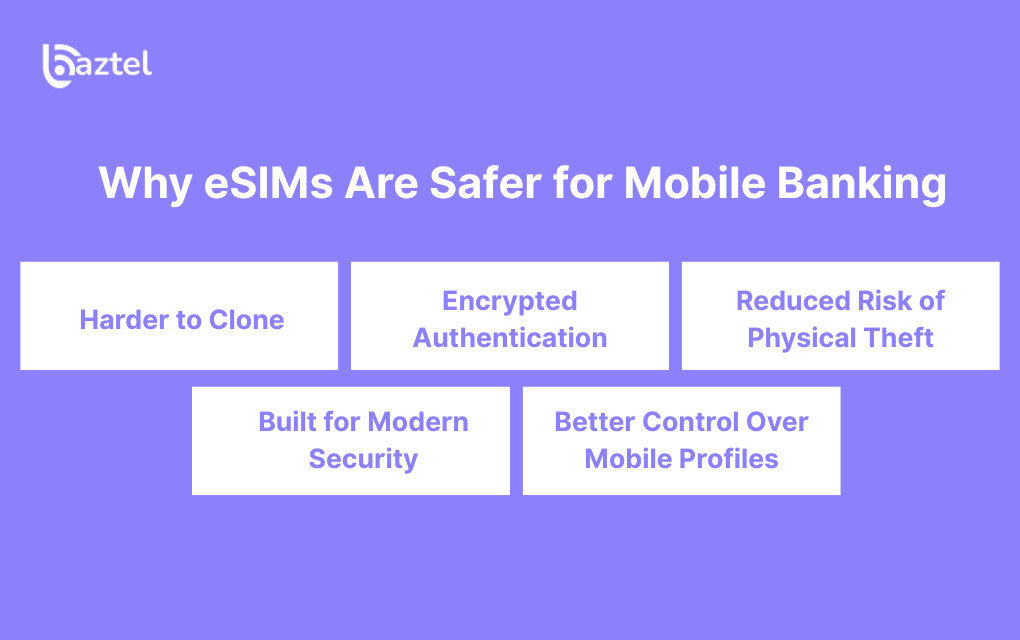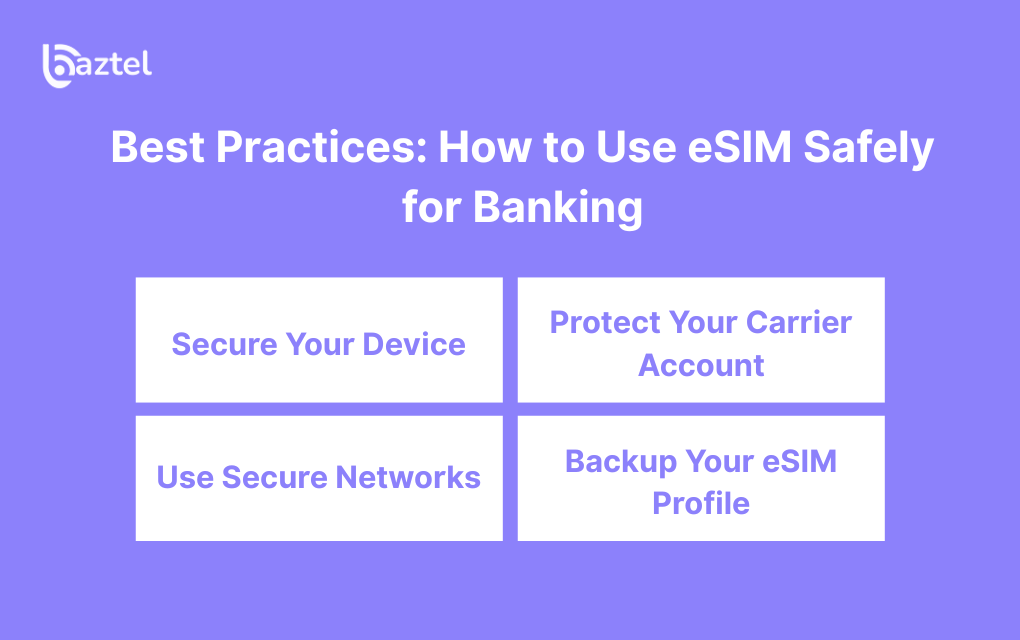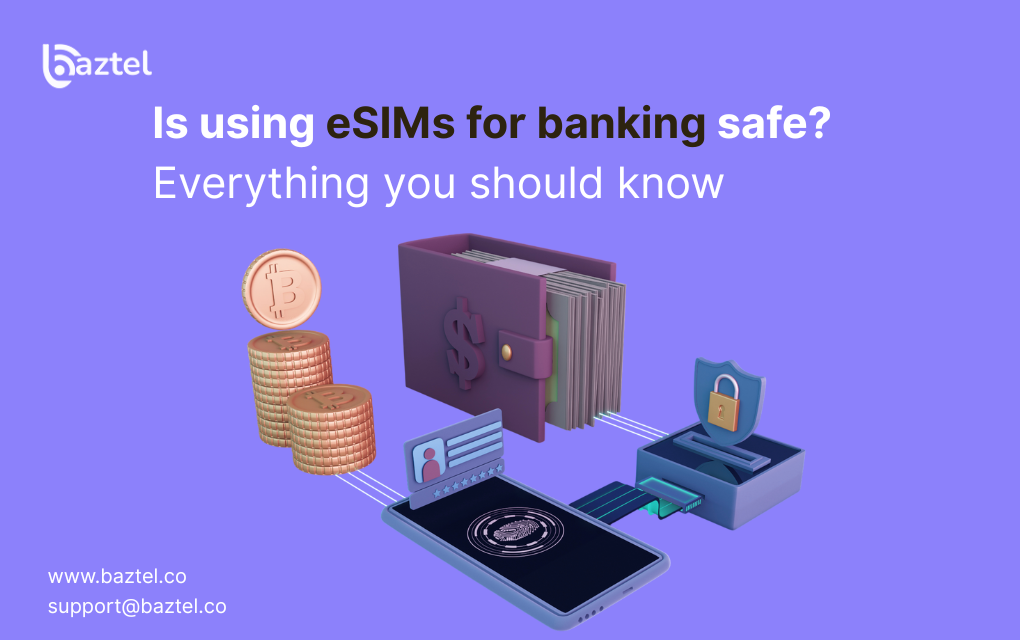Mobile banking is increasingly popular, and understanding the best secure eSIMs for mobile banking is essential for safety and convenience. This guide covers everything you need to know about eSIM technology, its security benefits, top providers, and tips to keep your financial data protected.
This information is for anyone interested in secure mobile banking, including frequent travelers, professionals, and anyone concerned about mobile security. As our connection to mobile networks continues to develop quickly, eSIMs are accelerating this change, and choosing the best secure eSIMs for mobile banking is more important than ever.
Unlike traditional SIM cards, which you would physically insert into your phone, eSIMs (embedded SIMs) reside on the phone itself and can be activated and switched remotely from mobile carrier to mobile carrier. An eSIM is a digital SIM, meaning it is not a physical card but a digital profile built into your device, offering enhanced security benefits such as encryption and resistance to theft. Built into devices, this technology reduces the need for a SIM card and offers consumers a higher level of convenience and flexibility worldwide.
We cover how eSIMs work, their security benefits and risks, best practices, and the best secure eSIM providers for mobile banking. In addition to convenience, eSIM offers a new layer of innovation in connection, which enables faster layouts, support for more networks, and remote control of mobile profiles.
eSIMs also allow users to access cellular data without a physical SIM card, making it easier to stay connected, especially when traveling internationally or switching carriers. Travelers, professionals, and companies are increasingly approaching eSIM for the opportunity to keep in touch globally without relying on physical SIM replacement.
However, since eSIM gains popularity, an important concern arises: Are eSIMs safe for banking? Since mobile banking involves sensitive transactions and personal information, it is important to understand the security aspects of eSIM technology. In this blog, let’s find out how secure eSIMs are, what risks they can pose, and how to keep your financial information safe when you use a digital bank.
What is an eSIM and How Does It Work?
An eSIM (embedded SIM) is a digital SIM built into your smartphone that replaces the need for a traditional plastic SIM card. Unlike a regular SIM or physical SIMs, which require you to insert or swap a physical card, a digital SIM allows you to download a carrier profile directly to your device. This enables instant activations, easier switching between carriers, and enhanced security for your mobile connection.
How it works: Learn more about how it works
- Your device has the capability of using eSIM.
- You use your carrier’s app or scan a QR code to activate the eSIM.
- The eSIM is managed and securely stores all your carrier info digitally through your phone’s software. Make sure your phone’s software is always up to date to maintain the highest level of security.
- You can change networks without changing the physical SIM card.
Quick Comparison: eSIM vs Physical SIM Card
| Feature | eSIM | Physical SIM |
|---|---|---|
| Setup | Digital (QR code / app) | Manual insertion (requires SIM tray for regular/physical SIM) |
| Security | Harder to clone | Easier to duplicate |
| Convenience | Switch carriers instantly | Requires new SIM card |
| Risk of loss | Cannot be lost | Can be lost or stolen |
| Storage | Built-in | External card (inserted via SIM tray) |
Yes, in general it is safer to use an eSIM for banking than a traditional SIM card. eSIMs are built directly into your device, which means that they cannot be removed or physically cloned or replaced, which limits the potential for SIM-based fraud.
Unlike physical sims or a regular sim, which require a sim tray for installation and can be physically swapped, eSIMs offer added convenience and security. Furthermore, eSIM uses advanced encryption and authentication methods, increasing the difficulties for hackers trying to cut or manipulate your mobile connection significantly.
However, like any technology, the final level of security will eventually depend on how well you manage your devices and data. To maintain your security, it is important to keep the smartphone software up to date, turn on two-factor authentication, and avoid suspicious links and public Wi-Fi. With these security measures in place, your eSIM experience will provide a secure and reliable platform for all your mobile banking activities.
Why eSIMs Are Safer for Mobile Banking

The use of eSIMs enhances secure transactions in mobile banking by removing vulnerabilities associated with traditional SIM cards. eSIMs make SIM swapping more difficult because they are built into your device and activated remotely with carrier verification, which helps protect against sim swap attacks.
The non-determinate built-in design limits physical tampering, and if someone gains physical access to your device, eSIMs reduce the risk of unauthorized access compared to traditional SIM cards. Advanced encryption and remote-control abilities complicate efforts by cyber criminals to cut off data, clone SIMs or misuse personal data, providing robust security for digital transactions.
Modern smartphones with eSIM support advanced biometrics and hardware-level security, further enhancing protection for mobile banking.
Key Security Terms Explained
- Strong encryption refers to protocols like AES and RSA-2048 that protect your data during transmission and storage, making interception extremely difficult.
- Hardware-level security means security features are built directly into the device’s hardware, making it harder to tamper with or bypass.
- Advanced biometrics include fingerprint and facial recognition for secure authentication, ensuring only authorized users can access sensitive apps and data.
Strong encryption, hardware-level security, resistance to SIM swapping, and support for advanced biometrics are key features for secure mobile banking with eSIMs.
1. Harder to Clone
Traditional SIM cards can be cloned or swapped in order to steal phone numbers, redirect verification codes, and are particularly vulnerable to sim swap attacks. eSIMs, however, are already digitally embedded in the device and cannot be physically accessed and copied, making it exponentially more difficult for SIM swaps to take place while enhancing protection against unauthorized access to accounts and identity theft. eSIMs make SIM swapping more difficult because they are built into your device and activated remotely with carrier verification, adding an extra layer of security against unauthorized SIM exchanges.
2. Encrypted Authentication
eSIMs utilize strong encryption to authenticate your device with the mobile carrier, eliminating the possibility of data interception when communicating. This more secure authentication greatly reduces the chances of unauthorized access to your data and prevents “man-in-the-middle” issues to ensure that your sensitive information (such as banking information and one-time passwords) is secure during all mobile network transactions and verifications.
3. Reduced Risk of Physical Theft
Unlike physical SIM cards that can be stolen and inserted into another device, eSIMs are permanently built into your smartphone’s hardware, reducing the risk even if someone gains physical access to your device. This prevents thieves from reusing your SIM or accessing your mobile identity, greatly reducing the risk of identity fraud and unauthorized use of your banking accounts.
4. Built for Modern Security with Enhanced Security Features
Modern smartphones are designed to support these advanced eSIMs security features. eSIMs were developed with modern Internet of Things (IoT) and connectivity security standards in mind. They employ secure authentication, encryption, and network verification to protect communications across multiple platforms. This advanced framework ensures that sensitive data, including online banking transactions, remains shielded from modern cyber threats and hacking attempts.
5. Better Control Over Mobile Profiles
eSIM technology allows users to manage their mobile profiles remotely through device settings. If your smartphone is lost or stolen, you can instantly disable or delete your eSIM profile. This ability provides an additional layer of control and protection, minimizing potential misuse of your mobile identity or financial data.
Now that you understand why eSIMs are safer for mobile banking, let’s examine the potential risks you should be aware of.
Potential Risks of Using eSIM for Banking
Although eSIMs offer advanced security features, they are not completely immune to cyber threats. Risk usually occurs from user behavior, vulnerabilities in the devices, and false management of accounts, rather than errors in eSIM. It is crucial to keep your phone’s software up to date, as outdated software can expose your device to security vulnerabilities.
Hackers can still utilize weak passwords, outdated software or phishing attempts to access sensitive economic information. Using public wifi for banking can also increase the risk of cyberattacks, so it is recommended to use a VPN or avoid public networks when accessing financial accounts. Additionally, Over-the-Air (OTA) security updates allow eSIMs to receive continuous security updates wirelessly, patching potential vulnerabilities.
In addition, limited transport support in some areas can expose users to unsafe activation networks. Understanding these potential risks can help you take preventive measures and maintain a safe mobile banking experience.
Common Risks of Using eSIM for Banking: SIM Swapping
| Risk Type | Description | Potential Impact | Preventive Measures |
|---|---|---|---|
| SIM Swap Scams (Digital) | Hackers gain access to carrier accounts or credentials to activate your number on another device (sim swap attacks). | Unauthorized access to banking OTPs and financial accounts. | Use strong passwords, enable 2FA, and monitor carrier notifications. |
| Device-Level Vulnerabilities | Outdated, rooted, or malware-infected devices compromise app and data security. | Data theft, financial fraud, or identity exposure. | Keep software updated, install trusted apps only, and use antivirus tools. |
| Phishing and Social Engineering | Fraudulent emails, calls, or texts impersonating banks or carriers trick users into revealing data. | Loss of personal information or unauthorized account access. | Verify sender details, avoid clicking unknown links, and report suspicious messages. |
| Unsecured Public Wi-Fi | Connecting to public wifi networks exposes sensitive data to interception by cybercriminals. | Data theft, account compromise, or unauthorized transactions. | Use a VPN, avoid banking on public wifi, and connect only to trusted networks. |
| Limited Carrier Support | Some regions or networks may lack proper eSIM infrastructure and secure activation channels. | Exposure to insecure Wi-Fi or unreliable service during setup. | Activate eSIM only on trusted networks and verified carrier apps. |
Now that we’ve covered the main risks, let’s look at how to choose the best eSIM providers and plans for secure mobile banking.
Best Secure eSIM Providers for Mobile Banking
Choosing a reputable eSIM provider with strong security practices is crucial for secure mobile banking. Here are the top secure eSIM providers and their key security features:
| Provider | Key Security Features |
|---|---|
| Airalo | Adheres to stringent security standards including GDPR, PCI DSS, and SOC 2 Type II. |
| Holafly | Implements security measures to protect against unauthorized access and provides a secure connection via reliable local networks. |
| Saily | Developed by the team behind NordVPN, offers strong built-in security features including web protection, an ad blocker, and the option to change your virtual location. |
| BazTel | Fully GSMA-compliant, adhering to stringent security protocols including secure provisioning, encrypted communications, and certified protection across all eSIM operations. |
eSIM Providers, Mobile Networks, and Data Plans
Choosing the right eSIM provider is essential for anyone looking to maximize the benefits of eSIM technology, especially when it comes to mobile data and mobile security. Today’s eSIM providers offer a wide range of options, from unlimited data plans to flexible regional plans and daily plans that can be tailored to your specific needs. Popular eSIM brands like Airalo, BazTel, Saily, and Holafly make it easy to stay connected, whether you’re at home or traveling across multiple countries.
Unlike traditional SIM cards, eSIMs allow you to switch between different mobile networks and data plans directly from your device, without the hassle of swapping out a physical sim card. This flexibility is particularly useful for frequent travelers or anyone who needs to manage multiple devices or phone numbers. Many eSIM providers also prioritize mobile security, offering enhanced features such as biometric authentication and two-factor authentication to protect your sensitive data and online banking activities.
When comparing eSIM services, consider factors like coverage, high speed data availability, and pricing. Some providers offer unlimited plans for heavy data users, while others focus on affordable regional plans or pay-as-you-go daily plans. By researching and comparing the offerings of different eSIM providers, you can find the best solution to stay connected, save money, and enjoy the added security that eSIM technology brings—unlike traditional sim cards, which often require a local sim card or a new physical card for each country or network.
Key Security Features to Look for in a Secure eSIM Provider
When selecting a secure eSIM provider for mobile banking, look for these essential security features:
- Embedded secure elements: Hardware-based security modules built into the device to protect sensitive data.
- Strong encryption protocols: Use of industry-standard encryption like AES and RSA-2048 to safeguard data during transmission and storage.
- Secure remote provisioning: The ability to securely download and manage eSIM profiles over the air.
- Robust carrier authentication standards: Ensures only authorized users and devices can activate and use the eSIM.
- Continuous OTA security updates: Regular over-the-air updates to patch vulnerabilities and enhance security.
With the right provider and security features in place, you can further enhance your safety by following best practices for secure mobile banking.
Best Practices: How to Use eSIM Safely for Banking

To keep your eSIM and banking data secure, follow these best practices:
Device Security
- Use strong passwords or biometrics (fingerprint, facial recognition, or Face ID).
- Keep your OS and banking apps updated.
- Avoid rooted or jailbroken devices.
Carrier Account Protection
- Set a PIN or password on your carrier account.
- Enable two-factor authentication (2FA) where available.
- Monitor carrier notifications for unusual activity.
- For secure and reliable connectivity when traveling, consider the best eSIM options for Canada, including coverage in national parks like Banff and Jasper.
Network Security
- Avoid public Wi-Fi for banking transactions.
- Consider using a VPN for added privacy when abroad.
eSIM Backup
- Keep a secure backup of your eSIM activation details or QR code.
- Some phones allow cloud backups for easier recovery.
By following these best practices, you can maximize the advantages of eSIM technology for banking and beyond.
Advantages of Using eSIM for Banking and Beyond
eSIMs offer a range of benefits for mobile banking and general connectivity. Here are the key advantages, each explained for easy navigation:
High Security
- Built-in encryption and no physical access make eSIMs highly secure against cloning and tampering.
Convenience
- Instant activation, carrier switching, and the ability to use one eSIM for multiple trips and locations.
Eco-Friendly
- Reduces plastic SIM card waste, making it a greener choice.
Multiple Profiles
- eSIMs support multiple profiles securely, allowing you to have separate profiles for work and personal use on one device.
Flexible Data Plans
- eSIMs provide flexible data plans with simple online top-off.
Easy Local Activation
- Download and activate local mobile plans without visiting a physical store.
Multiple Devices
- eSIMs can be used on multiple devices, including smartwatches and tablets.
Remote Management
- Easily disable or reassign eSIM remotely for added control.
Reference Table:
| Advantage | Description |
|---|---|
| High Security | Built-in encryption and no physical access. |
| Convenience | Instant activation, carrier switching, and the ability to use one eSIM for multiple trips and locations. |
| Eco-Friendly | Reduces plastic SIM card waste. |
| Multiple Profiles | eSIMs support multiple profiles securely, allowing you to have separate profiles for work and personal use on one device. |
| Flexible Data Plans | eSIMs provide flexible data plans with simple online top-off. |
| Easy Local Activation | Download and activate local mobile plans without visiting a physical store. |
| Multiple Devices | eSIMs can be used on multiple devices, including smartwatches and tablets. |
| Remote Management | Easily disable or reassign eSIM remotely. |
For professionals and frequent travelers, these advantages are especially valuable when banking and staying connected abroad.
International Travel with eSIMs: What Professionals Need to Know
For professionals who travel internationally, eSIM technology offers significant advantages over traditional physical sim cards. With an eSIM, you can access mobile data and stay connected to your banking apps and clients without the need to hunt for a local sim or worry about losing a physical card. eSIM technology offers enhanced security features, such as biometric authentication and two-factor authentication, providing an extra layer of security for sensitive activities like online banking.
However, international travel also brings unique risks, including sim swapping and phishing attacks. To protect your data and financial information, it’s important to enable two-factor authentication on your banking apps, use strong passwords, and keep your phone’s software up to date. Choosing a reputable eSIM provider that offers robust data encryption and advanced security features can further reduce the risk of identity theft or unauthorized access.
By understanding both the benefits and potential risks, bankers can make informed decisions about using eSIMs abroad. With the right precautions—such as avoiding public wi fi networks, using a VPN, and selecting providers with strong security protocols—eSIM technology offers a secure, flexible, and convenient way to stay connected and conduct sensitive activities during international travel.
While eSIMs are generally secure, there are situations where you should exercise caution or avoid using eSIM for banking.
When Should You Avoid Using eSIM for Banking?
If your device lacks regular updates, uses unsecured networks, or your carrier has weak security, eSIM banking may be risky. Not all eSIMs support every feature, such as personal hotspots, and compatibility can vary depending on the carrier or region. Device vulnerabilities like outdated software or rooted phones further increase exposure.
In some regions, using a local provider and a reliable local network is important for better coverage, affordability, and security. The security of mobile banking primarily depends on user practices and the security of the bank’s app. In such cases, limit banking to secure environments.
- Your smartphone does not receive regular security updates, increasing vulnerability to malware and cyberattacks.
- Frequent use of unsecured public Wi-Fi exposes sensitive banking data to potential interception.
- Your mobile carrier lacks strong account protection features such as two-factor authentication (2FA) or account verification.
- Device-level risks, including outdated software or rooted/jailbroken phones, can compromise financial security.
- In such cases, it’s safer to use eSIM for general connectivity and limit banking activity to secure environments.
eSIM Banking Caution Checklist
| Risk Factor | Description | Potential Impact | Recommended Action |
|---|---|---|---|
| Outdated Device | The phone lacks the latest OS/security updates. | Increased vulnerability to malware and cyberattacks. | Update software regularly; avoid banking on outdated devices. |
| Unsecured Public Wi-Fi | Using open Wi-Fi networks for connectivity. | Data interception, exposure of banking credentials. | Use VPNs; perform transactions on secure networks only. |
| Weak Carrier Security | Carrier does not support 2FA or account verification. | Higher risk of SIM swap or unauthorized access. | Enable carrier security features; verify account protection. |
| Device Compromise | Rooted or jailbroken phones. | Malware can bypass security controls, risking sensitive data. | Avoid rooted/jailbroken devices for banking. |
| Limited eSIM Usage | Using eSIM only for banking in insecure conditions. Not all eSIMs support every feature, such as personal hotspots, and compatibility can vary by carrier or region. Coverage and service quality may depend on the local provider and the reliability of the local network, especially in remote areas. | Potential financial and identity loss. | Restrict eSIM to general connectivity; perform banking on secure devices/networks. When traveling, consider choosing a local provider and ensure your eSIM connects to a reliable local network for better coverage and security. |
As eSIM technology continues to evolve, the future of secure mobile banking looks even more promising.
The Future of eSIMs in Banking
The future of eSIMs in banking is bright, with eSIM technology poised to transform how we approach mobile security and online banking. As more banks and financial institutions adopt eSIM-based services, users can expect even greater security advantages, including advanced biometric authentication and state-of-the-art data encryption. These innovations will make it even harder for cybercriminals to compromise sensitive data, providing a safer environment for all your banking needs.
One of the most significant advantages of eSIMs is their flexibility—users can easily switch between data plans, providers, and even countries, all without the need for a traditional physical sim card. This convenience, combined with enhanced security features, positions eSIMs as the future standard for secure mobile banking and sensitive activities.
As eSIM technology continues to evolve, we can anticipate new features such as improved web protection, seamless integration with multiple devices, and even more robust authentication methods. For bankers and financial institutions, this means a future where mobile banking is not only more secure but also more convenient and accessible than ever before. With eSIMs, the possibilities for innovation, global coverage, and enhanced mobile security are virtually unlimited.
To summarize, let’s review the key points about eSIM safety for banking.
Conclusion
So is it safe to use eSIM for a bank? Yes, and in many ways it is safer than using a traditional SIM card. eSIMs have strong encryption, external administrative options and hardware-level safety that make them difficult to clone or tamper with. These functions reduce the risk of SIM fraud and unauthorized access significantly.
However, complete security also depends on user behavior, keeps the device software up to date, uses strong passwords and is awake for phishing fraud. With the right precautions, eSIM provides a modern, efficient and very secure platform to safely manage your banking activities in the digital age.
FAQs
Can hackers steal my eSIM information?
Not easy. eSIMs are encrypted and securely bound to the device’s hardware, making it difficult to steal data. However, phishing and harmful software can still expose sensitive bank details, so always be vigilant and keep the device updated.
Is eSIM more secure than a physical SIM for banking?
Yes. eSIMs offer high security, as they cannot easily be removed, cloned or replaced. It reduces the risk of SIM-based attacks and provides a safe environment to carry out mobile and online banking transactions.
What should I do if my eSIM phone is stolen?
Contact your carrier immediately to disable or suspend your eSIM profile and inform your bank to stop the transactions. You can also externally track or dry the device to prevent unauthorized access to sensitive data.
Can I use eSIMs safely while traveling abroad for banking?
Yes. Using a travel eSIM is a secure and convenient way to access mobile banking internationally. Travel eSIMs provide a secure internet connection and can offer more data options for travelers. For reliable service, choose a country specific eSIM or an international plan tailored to your destination, as these ensure compatibility with local carriers and stable connectivity.
Always activate service from trusted providers, avoid public Wi-Fi, and use a VPN when accessing your mobile banking app for safer transactions abroad.
Are all banks compatible with eSIM devices?
Yes. eSIMs work at the network level and do not affect app compatibility. As long as your smartphone supports mobile banking applications, all major banks function seamlessly with eSIM connectivity.
What are the security features of popular eSIM providers?
Holafly implements security measures to protect against unauthorized access and provides a secure connection via reliable local networks. Holafly is also noted for its 24/7 customer support and offers customizable data plans for travelers.
Saily, a recently launched service developed by the team behind NordVPN, is recognized for its strong built-in security features, including web protection, an ad blocker, and the option to change your virtual location.
BazTel is fully GSMA-compliant and adheres to the most stringent security protocols ensuring secure provisioning, encrypted communications and certified protection across all eSIM operations.
No author found.

 Botswana
Botswana Zambia
Zambia Congo
Congo Colombia
Colombia China mainland
China mainland Chile
Chile Chad
Chad Central African Republic
Central African Republic Canada
Canada Cameroon
Cameroon Cambodia
Cambodia Burkina Faso
Burkina Faso Bulgaria
Bulgaria Brunei Darussalam
Brunei Darussalam Brazil
Brazil Aland Islands
Aland Islands Bosnia and Herzegovina
Bosnia and Herzegovina Bolivia
Bolivia Belgium
Belgium Belarus
Belarus Bangladesh
Bangladesh Bahrain
Bahrain Azerbaijan
Azerbaijan Austria
Austria Australia
Australia Armenia
Armenia Argentina
Argentina Algeria
Algeria


